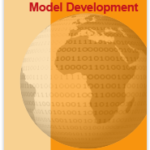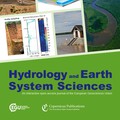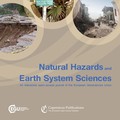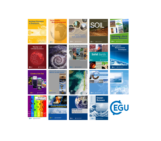
Each month we feature specific Divisions of EGU and during the monthly GeoRoundup we will be putting the journals that publish science from those Divisions at the top of the Highlights roundup. For October, the Divisions we are featuring are: Natural Hazards (NH), Hydrological Sciences (HS) and Seismology (SM). They are served by the journals: Geoscientific Model Development (GMD), Hydrology and Earth System Sciences (HESS), Natural Hazards and Earth System Sciences (NHESS), SOIL, and Solid Earth (SE).
Featured highlights
 Predicting the morphology of ice particles in deep convection using the super-droplet method:development and evaluation of SCALE-SDM 0.2.5-2.2.0, -2.2.1, and -2.2.2 – 1 October 2020
Predicting the morphology of ice particles in deep convection using the super-droplet method:development and evaluation of SCALE-SDM 0.2.5-2.2.0, -2.2.1, and -2.2.2 – 1 October 2020
Using the super-droplet method, we constructed a detailed numerical model of mixed-phase clouds based on kinetic description and subsequently demonstrated that a large-eddy simulation of a cumulonimbus which predicts ice particle morphology without assuming ice categories or mass–dimension relationships is possible. Our results strongly support the particle-based modeling methodology’s efficacy for simulating mixed-phase clouds.
An improved mechanistic model for ammonia volatilization in Earth system models: Flow of Agricultural Nitrogen version 2 (FANv2) – 27 October 2020
Mostly emitted by the agricultural sector, ammonia has an important role in atmospheric chemistry. We developed a model to simulate how ammonia emissions respond to changes in temperature and soil moisture, and we evaluated agricultural ammonia emissions globally. The simulated emissions agree with earlier estimates over many regions, but the results highlight the variability of ammonia emissions and suggest that emissions in warm climates may be higher than previously thought.
Hydrology and Earth System Sciences (HESS)
 In situ measurements of soil and plant water isotopes: a review of approaches, practical considerations and a vision for the future – 13 October 2020
In situ measurements of soil and plant water isotopes: a review of approaches, practical considerations and a vision for the future – 13 October 2020
Water isotopes are a scientific tool that can be used to identify sources of water and answer questions such as From which soil depths do plants take up water?, which are highly relevant under changing climatic conditions. In the past, the measurement of water isotopes required tremendous effort. In the last decade methods have advanced and can now be applied in the field. Herein, we review the current status of direct field measurements of water isotopes and discuss future applications.
Natural Hazards and Earth System Sciences (NHESS)
 Storm tide amplification and habitat changes due to urbanization of a lagoonal estuary – 13 October 2020
Storm tide amplification and habitat changes due to urbanization of a lagoonal estuary – 13 October 2020
The geometry of estuaries is often altered through dredging to make room for ships and with extensive landfill over wetlands to enable development. Here, we use historical maps to help create computational models of seawater flow around and into a lagoonal bay of New York City for the 1880s and 2010s. Our results show that these past man-made changes cause higher coastal storm tides and that they result specifically from deeper depths, expanded inlet width, and landfill.
Other highlights
Atmospheric Chemistry and Physics:
Comparing secondary organic aerosol (SOA) volatility distributions derived from isothermal SOA particle evaporation data and FIGAERO–CIMS measurements – 1 October 2020
Vertical profiles of light absorption and scattering associated with black carbon particle fractions in the springtime Arctic above 79∘ N – 6 October 2020
Increase in ocean acidity variability and extremes under increasing atmospheric CO2 – 29 October 2020
A Bayesian framework for emergent constraints: case studies of climate sensitivity with PMIP – 6 October 2020
The future sea-level contribution of the Greenland ice sheet: a multi-model ensemble study of ISMIP6 – 15 October 2020
A protocol for calculating basal melt rates in the ISMIP6 Antarctic ice sheet projections – 20 October 2020
ISMIP6 Antarctica: a multi-model ensemble of the Antarctic ice sheet evolution over the 21st century – 20 October 2020
Impact of an educational program on earthquake awareness and preparedness in Nepal – 22 October 2020
Current glacier recession causes significant rockfall increase: the immediate paraglacial response of deglaciating cirque walls – 8 October 2020
A 6-year lidar survey reveals enhanced rockwall retreat and modified rockfall magnitudes/frequencies in deglaciating cirques – 8 October 2020
Timing of exotic, far-traveled boulder emplacement and paleo-outburstflooding in the central Himalayas – 27 October 2020
Dominant process zones in a mixed fluvial–tidal delta are morphologically distinct – 29 October 2020
Nonlinear Processes in Geophysics:
Review article: Hilbert problems for the climate sciences in the 21st century – 20 years later – 15 October 2020
The Ekman spiral for piecewise-uniform viscosity – 22 October 2020
EGU Science in the News
A snapshot of recent English-speaking news coverage about EGU and its 19 open access journals:
- The Politico article How Biden would use trade agreements to fight global warming referenced a Biogeosciences study by Peters et al.
- A dozen outlets published articles based on an ACP study by Purohit et al., including Climate-friendly cooling to help ease global warming
- Disseminating Scientific Results in the Age of Rapid Communication in AGU’s Eos mentioned EGU’s open-access journals as examples of publications with “rapid dissemination but with rigorous scientific analysis”
- Benefits of EGU 2020: Sharing Geoscience Online continue to be discussed in the media, including Are virtual events a threat to the conference tourism? and Opportunities and Challenges of Virtual Meetings



